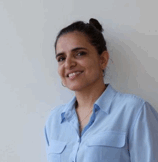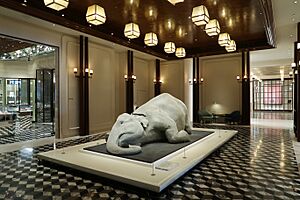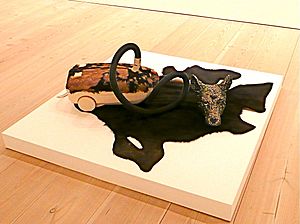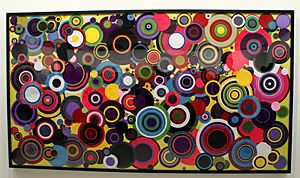Bharti Kher facts for kids
Quick facts for kids
Bharti Kher
|
|
|---|---|
 |
|
| Born | 1969 (age 55–56) London, England
|
| Education | Newcastle Polytechnic |
| Spouse(s) | Subodh Gupta |
Bharti Kher is a famous artist known for her unique and creative works. She has been making art for almost 30 years. Her art includes paintings, sculptures, and large art installations. Bharti Kher often explores ideas about the human body and how things change. She uses everyday objects in new and surprising ways. Her art often makes you think about different times and ideas.
Contents
Early Life and Art Journey
Bharti Kher was born in London, England, in 1969. She studied art at Middlesex Polytechnic in London from 1987 to 1988. After that, she went to Newcastle Polytechnic from 1988 to 1991. There, she earned a degree in Fine Art, focusing on painting. In 1993, she moved to India, where she still lives and works today.
Exploring Art Themes
Bharti Kher's art often looks at how we see ourselves. She explores how we connect with other people, animals, places, and everyday objects. She also uses ideas from different stories and traditions. Her work can make you think about cultural ideas and social rules.
The Bindi in Art
Bharti Kher is well-known for using the bindi in her art. A bindi is a dot worn on the forehead, especially in India. It comes from a Sanskrit word meaning "point" or "dot." Traditionally, it represents a spiritual "third eye." Over time, bindis became popular accessories.
Kher uses many bindis to create detailed and colorful "paintings." These works connect to ideas like repetition and sacred traditions. They also show how art can take something old and make it new. The bindi becomes a special language in her art. It links Western and Indian art styles.
One of her most famous works is The Skin Speaks a language not its own (2006). This sculpture is a life-sized elephant made from fiberglass. It is covered with many bindis. This artwork combines two important symbols of India: the bindi and the elephant, which is sacred in Hinduism.
Transforming Materials
Bharti Kher often explores the idea of transformation. She takes materials and gives them a new life. Her "Intermediaries" series is a great example. For these works, she collects brightly painted clay figures. These figures are traditionally displayed in South India during festivals.
Kher then breaks these figures and puts them back together. She creates amazing, imaginary creatures. These can be animal mixes or strange, unique people. She takes old stories apart and creates her own new legends.
Finding Balance in Art
Kher's art also looks at the idea of balance. She is inspired by ancient math and sacred shapes. She tries to find a "steady state" by putting together unusual elements. She uses everyday objects that seem very different. Yet, she brings them together in a delicate and surprising way.
Women and the Body in Art
Throughout her career, Bharti Kher has focused on the human body. She explores her own body and the bodies of women around her. She uses many different art forms to do this. For example, her "Warrior series" includes works like Cloudwalker and The messenger. She also has "Sari portraits" where she drapes sculptures in resin-coated saris.
Kher sees the body as a way to explore ideas about gender and stories. A key part of her work is casting. This is where she makes molds of real people. She sees this as a very personal way to capture their feelings, not just their physical shape.
One important series is Six Women (2013–2015). These are life-sized sculptures of women sitting down. Kher created them by casting real women in her New Delhi studio. She wanted to show the human emotions of her subjects.
Bharti Kher uses many materials in her art. Her main material is often manufactured bindis. She also uses repeating patterns in her paintings from her early student days. Kher's art often shows human feelings and love. Her sculptures and collages often mix different ideas, like race and gender.
Art Exhibitions
Bharti Kher's art has been shown in many places around the world.
Recent Solo Exhibitions
- The Body is a Place, Arnolfini, Bristol (2022-23)
- A Consummate Joy, Irish Museum of Modern Art (2020)
- The Unexpected Freedom of Chaos, Galerie Perrotin New York (2020)
- A Wonderful Anarchy, Hauser & Wirth Somerset (2019)
- Djinns, Things, Places, Galerie Perrotin Tokyo (2018)
- Chimeras, Centre Pasqu'Art Biel (2018)
- Dark Matter, Museum Frieder Burda Berlin (2017)
- This Breathing House, Freud Museum London (2016)
- The Laws of Reversed Effort, Galerie Perrotin, Paris (2016)
- Matter, Vancouver Art Gallery, Vancouver (2016)
- In Her Own Language, Lawrence Wilson Art Gallery Perth (2016)
- Three decimal points. Of a minute of a second. Of a degree, Hauser & Wirth, Zürich (2014)
- Misdemeanours, Rockbund Art Museum, Shanghai (2014)
Recent Group Exhibitions
- In the Company of Artists, Isabella Stewart Gardner Museum (2019)
- Desire: A revision from the 20th Century to the Digital Age, Irish Museum of Modern Art (2019)
- Surface Work, Victoria Miro, London (2018)
- Facing India, Kunstmuseum Wolfsburg, Wolfsburg (2018)
- Like Life: Sculpture, Colour and the Body (1300-Now), The Metropolitan Museum, New York (2018)
Art Collections
Bharti Kher's artworks are part of important art collections. You can find her work at the Tate Modern in London. Her art is also in the Vancouver Art Gallery and the Walker Art Center.




